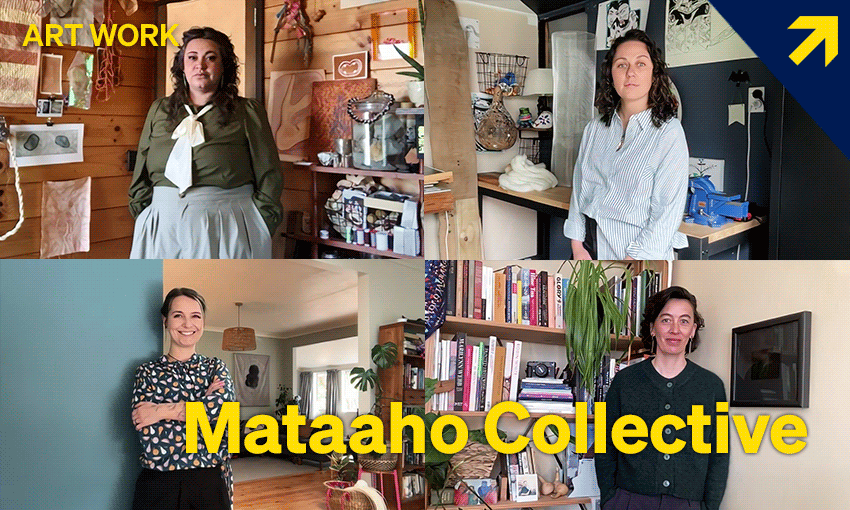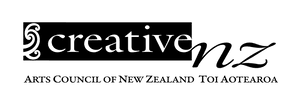The Mataaho Collective is an award-winning group of four New Zealand artists – Erena Baker (Te Atiawa ki Whakarongotai, Ngāti Toa Rangātira), Sarah Hudson (Ngāti Awa, Ngāi Tūhoe), Bridget Reweti (Ngāti Ranginui, Ngāi Te Rangi) and Terri Te Tau (Rangitāne ki Wairarapa) – established in 2012. Their works include Kiko Moana, AKA, the Walters Prize-winning Atapo, and Takapau, winner of the Venice Biennale Golden Lion.
How they frame their arts practice
We’re installation artists with kaupapa Māori foundations. We’re inspired by textile and fibre-based practices. We love to use industrial materials that are used in the labour force as an ode to our roots, our families.
We also like to think about how we can take up a lot of space in institutions, and how our work can respond to space, be it the location or the actual architecture of a building that the work will be in. It’s about claiming space for wāhine Māori in institutions and being visible within the wider art community.
How the collective came into being and sustains their collaborative practice
Every collective works differently and is structured in different ways, but we’ve always worked with the goal of having a co-authorship – the things we create together are a product of all of our ideas and inspirations, and experimentation and research. The closest equivalent would be being in a band together – or in our case, maybe a barbershop quartet!
When we came together in 2012 we had the idea of this single-authorship lens, and we set some guidelines as well because individually we had lens-based practices. We wanted to do something different and a lot of those goals have stuck, and stayed as foundations.
The logistics of making work as a collective
It’s a juggle! We like to say we have a wananga-based practice, so that involves us coming together for intensive periods of time. When we’re making or conceiving a work it may be a week or over a long weekend. We’ll block out time where we’re not distracted by all the other things that impact our lives. We’ve learned to work really efficiently in those times.
Then there’s the other side of it when we’re not in the same space physically so we have to have those boring weekly meetings online because we live in different places. They’re not too bad but they’re not as fun as the actual making of the artwork! The only reason they’re boring is the amount of admin that goes along with sustaining a practice like this.
There are requests coming from different institutions and people, so it’s about thinking about how we want to divide our time, and what are the most meaningful projects for us to dive into.
How long a project takes from conception to completion
It takes roughly about a year, depending on how big the project is. An example might be AKA, for which we were commissioned by the National Gallery of Canada in 2019. From conception to installation was around a year, and that project needed a big space to be able to work on it over a long period of time.
Each project looks different. With AKA we’d come together and work on that on weekends, after work and things like that. Other ones we can work on separately at home and we’ll be tinkering away, sewing or weaving to doing whatu alone, and those components can come together at the end to form a large-scale thing.
Sometimes, like in the case of Takapau, we can do a lot of the planning on paper and modelling but then all the intensive labour happens right at the end in the gallery because that project needs to be made within the space. So each one looks quite different but those projects take around about a year.
We don’t have dealers or producers or managers, it’s just us four. We plan, test, and work with manufacturers and engineers. It’s a weekly administrative practice as much as it is a creative practice to uphold these longer term timelines.
What their Venice Biennale experience was like
We were pretty aware of the intense mahi we had to do within the installation timeframe. Having installed Takapau once before at Te Papa, we all had a clear understanding of what it took to put that work up. We were also going in without two hands – Bridget was unable to come because she was so close to having her baby. So it was more about just getting our working brains on and not focusing too much, really, that the work was going to be in the Venice Biennale and that it was one of the welcoming works in the Arsenale.
We were going into an Italian institution and we get pretty intense in our making phase, so communication is key. We were working at height with this work, about seven metres up and our working-at-height licences didn’t cross over to working in Italy. We were really grateful for Google Translate on our phones – “up”, “down”, “yes”. We used lots of thumbs up, lots of smiles, and learnt a few Italian sayings by the end of it.
It also felt like a lot of responsibility. There wasn’t a New Zealand pavilion this time, and New Zealand at Venice [Biennale] felt unknown in terms of all the moving parts. It was cool to be alongside the other Aotearoa artists there, as well as the artists showing in different satellite shows.
We only started to let ourselves think about how many people would be walking under the work once it was up, and then it started to feel really exciting. Some parts of the install didn’t go as planned. In the last days, Erena had an accident. Her hand was badly injured and she had to go into hospital.
So there were super highs – finishing installing the work and overcoming the trickiness of how to weave that work – and then ultimate lows, when Erena had to go to another city and have surgery on her hand, leaving just one of us to pull through and finish the last parts of install, then oversee the lighting. It was a really extreme kind of roller coaster.
Receiving the Lion on top of that took it to another level of high.
How it felt to win the Golden Lion
We were shocked. We were so shocked even when we were at the awards ceremony. We were told that we’d been awarded “a” Lion, but we didn’t know which one.
We had less than 12 hours to consolidate. All of our husbands were there and Sarah’s eight-year-old kid was there, so that felt really special. It still feels pretty unreal.
Afterwards, we were walking through the exhibition and thinking about how the judges chose our work out of all those hundreds of amazing works. We felt really proud of how it looks in that context, which is quite different to the first iteration at Te Papa. We’re stoked it was in Te Papa for a year and that so many people got to see it at home first, and then it went to Europe to be seen in that context and it could stand on its own there too. That felt special. That our whānau had experienced that work before it went into a European art context.
What support they would like to see in place for younger Māori artists
Expanding opportunities for wānanga is crucial. Wānanga provide the cultural foundation and collaborative spaces where knowledge and experience can be shared across generations, ensuring that artistic practices are deeply rooted in tikanga Māori. Our experience has shown us firsthand the value of such spaces, as we came together through a series of wānanga in 2011, including Ngaru Roa, a Te Atinga Rangatahi Wānanga and an Artist and Activist Wānanga both held at Poupatate Marae. These wānanga were instrumental in shaping our collective practice, offering not only a platform for learning but also for forming meaningful relationships.
Beyond wānanga, we believe younger Māori artists need long-term mentorship programmes, funding systems that are accessible and align with Māori cultural values, and more opportunities for international exchanges. This would allow them to develop their practice, connect with indigenous art movements globally and strengthen their creative networks, all while maintaining a strong connection to their identity and community.
What keeps them going
We’ve achieved so much together and done things that we couldn’t have been able to in our individual art practices. We get to travel together and spend time in places that we wouldn’t have had the opportunity to without Mataaho.
And while there are four core members, we do reach out for a lot of support, expertise, mentorship and guidance. Over 12 years we’ve been really fortunate in the way that we’ve worked together, and also knowing that some processes need to change and develop.
We’re really aware that we need to keep shifting how we do things in order to keep working together. Going back to the barbershop quartet reference, we aren’t always in tune with each other; sometimes we can go pretty flat. Last year was the most challenging we’ve had in terms of group cohesion, but there’s a lot of learning that can happen in those moments.
Every time another project finishes, we know there’s something cool on the horizon. We’re working quite far in advance now, so it’s always nice to have something to look towards. Having gone through 12 years of working together, we’ve learned so much. We’re all still here, doing it!

